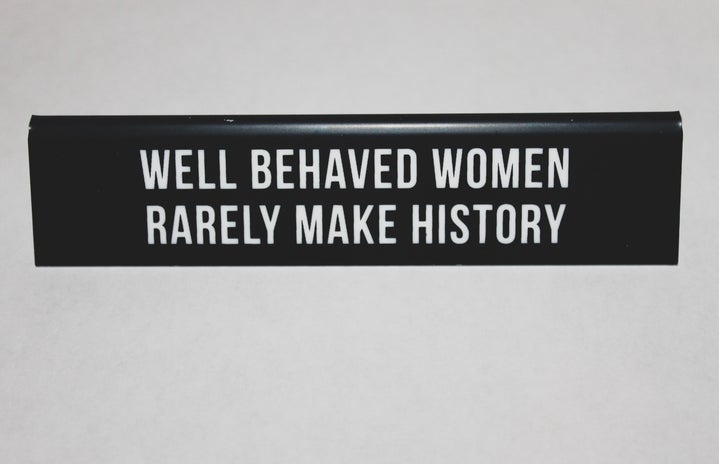March is a big month for collegiettes everywhere: it means the first day of spring, spring break, and the first days of the year where we can finally shed our winter coats and dig out our lighter wardrobes. In addition to all of this, March is also Women’s History Month, and serves as a time for us to remember and celebrate all of the wonderful women who paved the way for us. Here at UIC, one of the biggest names in women’s history is Jane Addams, a mid-1800’s reformer who opened up a settlement house in the area where UIC currently resides. The Jane Addams Hull House, while not as sprawling as it used to be, still stands in front of Student Center East as a museum where visitors can go and learn about Jane Addams, the reform movement, and the work that Hull House did for the community. Below you’ll find a profile on Jane Addams and a description of what Hull House has to offer, as well as an interview with Hull House educator-in-training Bethanie John!
Jane Addams
Born in Illinois in 1860, Jane Addams was the daughter of a wealthy businessman who taught her to value her education and gave her a love for books. She graduated from college in 1881 and soon went on to found the Hull House settlement with Ellen Gates Starr. Hull House was located on the west side of Chicago in what was known as the 19th Ward, an area which was greatly populated with European immigrants. Hull House provided programs for the community such as kindergarten and day care, education, galleries, libraries, and meeting spaces. Jane Addams worked at Hull House until her death in 1935, having accomplished many achievements in social reform.
Hull House
The Hull-House Museum currently has exhibits that detail the work that was done at Hull-House within the community of the 19th Ward, including the reports and investigations done by Hull-House workers, the educational and care opportunities provided to children that improved and gave specificity to the concept of childhood, and the contributions that Jane Addams made to the settlement. Additionally, you can learn about other reform movements and reformers that lived and made social change during Jane Addams’ time, tour Jane Addams’ bedroom and the Hull-House living area that contains a small library, and see an immersive exhibit that puts visitors into the 19th Ward community through visuals and sound. Museum admission is based on a suggested donation amount of $5, but if you can’t come up with the cash, you can still tour all of the exhibits. The Hull-House Museum is open Tuesday through Friday from 10 a.m. – 4 p.m. and Sundays from 12 p.m. – 4 p.m. For more information on the museum and Jane Addams, check out the interview below with educator-in-training Bethanie John!
HC: What is your role at Hull-House?
I am training to be a museum educator so I will eventually be giving tours.
HC: What does Hull-House seek to educate its visitors about?
Hull-House seeks to tell the stories of the people who lived at Hull-House as well as the working class people and immigrants who lived in the surrounding neighborhoods. I think a big part of what we do is link current issues such as work and eduction reform, class, race, U.S. born citizenship privilege back to Hull-House and to show that these issues are still extremely relevant.
HC: How does the legacy of Jane Addams and Hull-House apply to modern day social justice issues such as feminism, LGBTQ+ rights, and civil rights?
Feminist, LGBTQ+ rights, and Civil Rights issues all have roots at Hull-House. The founding of Hull-House by Jane Addams and Ellen Gates Starr was a bold move during their time when women were expected to lead private home lives. Addams and Starr used their gender roles and the idea of domesticity to transform what that meant. They were able to create a community within the home that challenged the way society functioned. Additionally, many of the reformers associated with Hull-House were women.
We have an LGBTQ+ tour that was created and given by one of our educators Michael. Jane Addam’s life partner was a woman named Mary Rozet Smith. We hesitate to use the term lesbian because that was not what they would have been called at the time. Their relationship is more characterized as a “Boston marriage” in which members of the same sex are in a partnership that is not sexual. This was very common at the time. We do know that Addams and Smith had a loving partnership, but whether it was romantic is something that is hard to confirm because almost all of the correspondence between Addams and Smith was destroyed.
Civil Rights issues are also rooted in Hull-House history. Jane Addams helped found the NAACP with Ida B. Wells. Ida B. Wells was a black woman who worked with and challenged Addams. She was an abolitionist that fought tirelessly to stop lynching and criminalization of black men. I personally wish there was more of a history of black people at the time coming through Hull-House, but because of our history of segregation, this wasn’t the case. There were other all black settlement houses at the time that I would encourage people to research.
HC: Why do you think that Jane Addams was considered “the most dangerous woman in America” by some?
Great question! One of the reasons Jane Addams was considered “dangerous” was because she allowed openly Communists to gather at Hull-House during a time when the U.S. was even more scared of communism. Addams eventually won the Nobel Peace Prize, she was a pacifist. We often ask visitors how Addams in one lifetime could be named the most dangerous woman in the world and win the Nobel Peace Prize.
HC: Why is Hull-House important to the UIC community?
The Hull-House is so important to the UIC community because first off, it’s the only building along with the Residence Dining Hall that has been preserved from the settlement. The legacy of Hull-House remains and the space is still a place for gathering for social justice and change. Some of the most transformative events I have witnessed have been at Hull-House. It’s also important because the history of Hull-House is so accessible. Students and the general public are always welcome during business hours to visit and ask questions. We also book tours through our website. [Hull-House Museum Website]
HC: What is your favorite fun fact about Jane Addams or Hull-House?
My favorite fun fact is Jane Addam’s relationship with Mary Rozet Smith. It was something I learned the first week being at Hull-House and still find fascinating.
HC: What kinds of opportunities does Hull-House have for UIC students (jobs, internships, research, etc.)
I don’t believe there are any jobs are internships currently available but students are always welcome to come and do individual research.
HC: If you could teach a stranger one thing about Jane Addams or Hull-House, what would it be?
My favorite thing about Hull-House and to tell people is that almost anything you’re interested in can be linked back to Hull-House!


